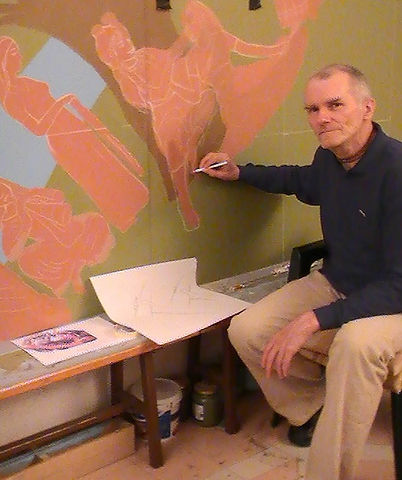
Rudradeva's Paintings
Rudradeva's Art
Rudradeva says,
"Throughout my lifetime, although I've executed, or experimented with many different styles of art, in terms of media, supports, venues, etc., I've always felt most comfortable with, and (not surprisingly) enjoyed the most success with oil paint. When I first tried oil paint in my pre-teens or early-teens, it was more or less "Love at first sight". Naturally, I was always impressed with the works of the masters, and it didn't take much to see that the vast majority of well-known masterpieces were executed in oil. But from my own creative standpoint, it was so nice to learn from the very first tests I made, how "forgiving" this medium was; in other words, "mistakes" could be easily rectified and re-done, unlike "less-friendly" mediums like watercolor, for instance.
Since I've been a devotee in ISKCON, which is the last 40+ years of my life, probably more than 90% of my artistic engagements in various temples, has involved the use of oil paint, either on canvas (for small to medium-size works) or wood panels (for larger to grand-size endeavors)".
The style Rudradeva paints in varies depending on the subject. In his portraits, one can notice the tight photo-realism style he employs. Of this, Rudra states,

"While some portrait artists use styles that afford a greater level of individual expression or interpretation of their subject, I see photo-realism as the best means to respect or honor my subject, by depicting him or her as close to the original photo as I can, with no "creative" interpretation. This is particularly important when portraying an important historical figure, the best example being Srila Prabhupada. In this regard, if I can take a small Kodak print of Prabhupada that illustrates some momentous period in his life, and translate that image into a lifelike oil painting on a huge wall or ceiling, then I feel like this rendering can be an important showcase of a part of his life, and in this way can thus become a valuable means of preaching his glories, for generations to come, who might otherwise never view the original small photo. And even tho it's just "copying a photo", if done with care, then the devotee-artist actually "injects" more life with the personal touch of his hand, channeling the love he feels for his spiritual master, so that, thru the oil paint, this translates onto the final painting".
As mentioned in his biography, Rudradeva received only a minimum of professional training. He says of this: "The little bit of in-classroom training I received was valuable, I would say. Through my limited and low-cost classes at The Miami Museum Art School, it was a good experience painting from live models, alongside other budding artists, and learning standard technique in the drawing classes. This brief bit of study helped to shape the way I approached my later projects for temples, and created a basic understanding of painting and drawing fundamentals, so that my creative energy could be free to explore and develop the best way to depict Krsna and His associates, or Prabhupada's pastimes."
But the main vehicle for the development or improvement of his painting style or technique was simply the experience of executing these various ISKCON temple projects from 1980s to present. Rudradeva says further:
"That's one of the things that I find most rewarding about getting to "practice" doing what I love to do, by completing an important ceiling mural or museum project. Besides the satisfaction of seeing the work completed and knowing that devotees are happy with the final result, there's the self-review of my work, in which I can see a personal growth in artistic 'expertise'. In other words, it is a source of great pleasure to me to be able to learn how to portray my spiritual master successfully, enough so that even someone who doesn't know Srila Prabhupada, can look at my painting and see his spiritual qualities shining through the canvas or wood. Or in the case of a scene depicting Krsna playing with His friends, for example, he or she may become inspired to learn more, and hopefully take up the reading of Prabhupada's books and the Vedic literatures, where all of the ideas for these various pastimes are derived from"
To sum up, Rudradeva says that probably the thing he likes most about painting is the fact that it seems to be one of the few things that he's able to do reasonably well. He says, "There's really not that much joy in having to smell paints, toxic mediums and cleaners, day-in and day-out, or cleaning brushes, palettes and workspace after every painting session, but all of that sacrifice can be taken in stride and forgotten when someone tells you, 'That's a really nice portrait of Srila Prabhupada'!"
